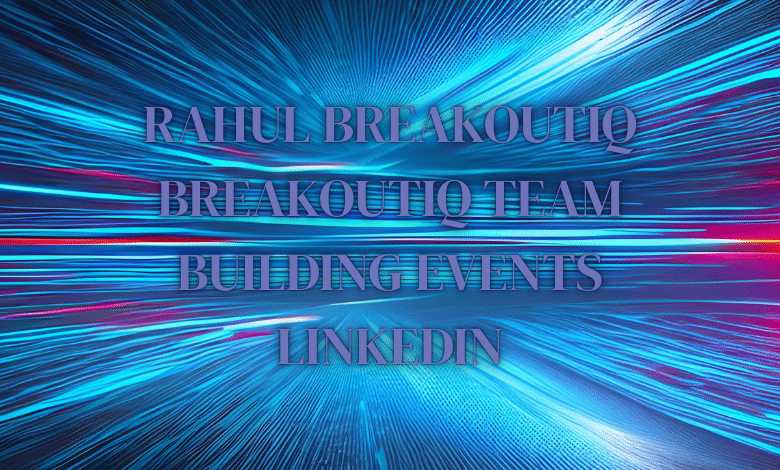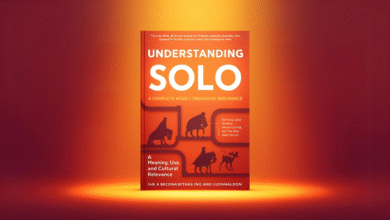Rahul breakoutiq breakoutiq team building events linkedin

Team building has shifted. Remote work, hybrid schedules, stretched attention spans—today’s workplaces need events that are more than a conference room icebreaker. You need experiences that build trust, connection, culture and bring out the best in people. That’s where Rahul Deedwania and BreakoutIQ come in. I’ve spent time reading their approach, checking their offerings, hearing what clients say. This is what I found, and what you can take away—even if you’re planning your own event.
1. Who is Rahul Deedwania & What Is BreakoutIQ
Rahul Deedwania is a leadership coach and co-founder of BreakoutIQ. He believes team building should not just be nice to have, but built intentionally—to spark connection, creativity and excellent collaboration. BreakoutIQ is a company he helped launch to design team building experiences that are fun, memorable, and that produce real impact.
The core idea is simple: design challenges and games that force communication, creative problem solving and teamwork. Whether virtual, in-person or hybrid, the events are crafted so people don’t just pass time—they build something together, learn about each other, and finish with something they can carry back into work.
BreakoutIQ started with portable, puzzle-based escape room style experiences for large groups. Over time they expanded the portfolio: virtual trivia, scavenger hunts, murder mysteries, “office feuds”, and hybrid mixes.
2. What Makes Their Approach Special
Here are the features that stand out to me:
-
Designed for impact: It’s not just about having fun. The design pushes participants to communicate, strategize, solve puzzles together. The more real the challenge, the more meaningful the takeaways.
-
Flexibility: They handle virtual, hybrid, or in-person. That matters a lot now, when teams may be half remote, half in the office. BreakoutIQ has specific offerings for remote or hybrid setups.
-
Easy planning: The logistics seem well taken care of. Book an event, choose virtual vs in-person, their team handles the hosting. For many organizations, planning is the hardest part—this kind of support is a big plus.
-
Thoughtful facilitation: The hosts are trained. They make sure rules are clear, that everyone participates, that timing works. Having a good host makes a big difference; I’ve seen team building events fall flat because of weak facilitation.
-
Good variety: If all events feel the same, people lose interest. BreakoutIQ’s variety (escape rooms, trivia, price-guessing games, scavenger hunts, etc.) means you can pick something that fits your team’s energy and preferences.
-
Strong social proof: They have testimonials from well known clients, good feedback, repeat business. That gives confidence.
Read Also: Blackboard Login CUCHD
3. Types of Events Offered
Here’s a breakdown of what BreakoutIQ offers, what works for whom, and when.
| Format | Some Examples | Best For / Advantages | Limitations |
|---|---|---|---|
| Virtual | Virtual escape rooms (e.g. Entertainer’s Escape, Hyperspace Escape), virtual murder mystery, virtual trivia, online scavenger hunts, icebreakers. | Great for remote teams; no travel; lower cost; can bring together people in different locations easily. Good for morale and breaking isolation. | Requires good tech; time-zone challenges; engagement can suffer if people are tired of Zoom or online meetings. |
| In-Person | Escape rooms on site; “Office Feud”; scavenger hunts around offices or campus; physical team quests. | Best when teams are co-located; energy is higher in person; easier to do physical or hands-on challenges; more organic interaction. | Travel, scheduling, cost; health/safety/logistics more complex; need physical space. |
| Hybrid | A mix: some participants in person, some remote; events designed so remote folks aren’t left out. Virtual hosts facilitate. | Flexible; allows everyone to join; good option when partial remote work is needed; helps with inclusion. | Managing two different audiences (in-person & remote) can be tricky; risk that remote feel secondary if not designed well. |
When choosing, think first about where your team is located, what tech you have, how much time and budget is available, how many people. Also think about what outcome you want: better communication? morale? creative thinking?
4. Why Team Building Events Matter
From what I’ve seen, events like those from BreakoutIQ offer benefits beyond a few laughs. Here are outcomes companies tend to get—and why they matter.
a) Better Communication & Understanding
When people work in different teams, departments, or time zones, they don’t always know each other’s strengths, styles or constraints. Team building forces people to talk, delegate, share, perhaps make mistakes together. That builds mutual understanding. As a result, later work flows better: fewer misunderstandings, better collaboration.
b) Morale, Engagement & Trust
Team building is great for morale. It breaks the monotony. Doing something fun together builds bonds. When people feel seen (especially remote teammates), trust and connection grow. A team that trusts each other will handle pressure better.
c) Creativity, Problem Solving & Innovation
Many events include puzzles, creative tasks, or games that need thinking differently. Those tasks can unlock fresh perspectives. Sometimes people discover skills or ideas in themselves they didn’t expect.
d) Culture & Inclusion
Organizing events that include everyone (remote, hybrid, in-person) signals that you value every team member. Inclusivity matters. Also, the themes or design of the event can reinforce company values: communication, respect, collaboration.
e) Measurable Business Value (ROI)
It’s not just “feel good.” Companies often look for results: more collaboration, fewer conflicts, better project outcomes. Some track metrics like employee satisfaction, retention, or performance improvements. If team events are done well, they can impact turnover, engagement scores, even productivity.
5. How to Plan a BreakoutIQ Event (or Similar)
If you were planning this kind of event—either with BreakoutIQ or using its principles—here’s a roadmap with things to consider, based on what I’ve learned.
Step 1: Define Objectives
Be clear: Why are you doing this event? Some possible goals:
-
Improve remote communication
-
Build trust among new hires
-
Celebrate a milestone
-
Break down silos between departments
Being clear will help you choose the right format and activity, and evaluate success later.
Step 2: Know Your Team
Gather info: how many people, where they are (locations & time zones), in person or remote; tech access; what people like/don’t like. Also understand energy levels and preferences: are people very competitive? More reflective? Do they enjoy puzzles or games?
Step 3: Choose Format & Activity
Based on objectives and team profile:
-
If many remote, choose virtual or hybrid events.
-
If co-located and you want high energy, maybe in-person quest or escape room.
-
If goal is creativity, maybe a brainstorming style game or innovation challenge.
-
Match difficulty of challenge to ensure everyone can participate.
Also consider logistics: scheduling, time zones, length (1 hour? half day?), host availability.
Step 4: Budget & Resources
Think about cost of event, cost of hosting, technology tools, facilitator fees, materials (if in-person), travel if required. Factor in time people spend, which is cost too. BreakoutIQ makes planning easier since many logistics are handled; but still know your limits.
Step 5: Facilitation & Execution
A good facilitator (or host) is crucial. That person or team:
-
Sets clear instructions
-
Monitors participation, ensures everyone is included
-
Keeps time, manages transitions
-
Encourages reflection: after event, discuss what groups learned, what they could apply back at work
Also ensure tech works: stable internet, tools, backup plans.
Step 6: Debrief & Measure
After the event, gather feedback. What worked? What didn’t? Use surveys or open discussion. Measure against your objectives: Did communication improve? Did people feel more connected? Did projects go more smoothly? Use qualitative and quantitative feedback.
6. Real Stories & Testimonials
What people say matters. From BreakoutIQ’s site and LinkedIn:
-
Clients report that the virtual escape rooms and trivia are “so much fun”, and even when people don’t win, the experience still builds team bonding. Experience is strengthened by the hosts.
-
For remote/hybrid teams, BreakoutIQ helps bridge isolation, bringing engagement in ways that many virtual meetings do not.
-
In feedback, many mention that the planning was smooth, hosts were responsive, events ran on time. That reliability matters a lot.
From what I gather, even clients who are skeptical at first often see value afterward.
7. How BreakoutIQ (and Rahul) Use LinkedIn
LinkedIn is part of the story. Rahul uses it to share insights, announce content, reflect on lessons from events. BreakoutIQ also posts content, testimonials, snippets of what goes on behind the scenes. That helps in three ways:
-
Authority & trust: when someone sees thoughtful content, they begin to trust the brand / person.
-
Social proof: seeing posts from clients, photos, comments gives evidence this is real, works.
-
Lead generation: posts can reach companies or professionals looking for team building.
If you are doing something similar: document your events, reflect on what worked, share images or quotes. Be authentic. People react more to human stories than marketing language.
8. Comparing BreakoutIQ with Other Team Building Providers
No provider is perfect; comparing helps you see what to prioritize.
| Feature | BreakoutIQ | Other providers (typical) |
|---|---|---|
| Flexibility (virtual / hybrid / in-person) | Strong and growing | Some focus mostly on in-person; others almost fully virtual |
| Facilitation / host quality | Good reviews say hosts are responsive and engaging | Mixed; often facilitation is weaker or less consistent |
| Variety of event types | Wide variety | Many providers specialize in trivia or escape rooms only or icebreakers only |
| Planning overhead (ease) | Low: BreakoutIQ handles a lot | More work required for coordination with some providers |
| Price transparency & client feedback | Many testimonials; seems reasonably priced | Some providers are opaque on cost or reviews |
If you evaluate providers, use checks: how often do their clients give feedback? Do they offer trial or sample events? What is the cancellation/refund policy? Are they experienced with your team size or type (fully remote, hybrid)?
9. Potential Limitations and How to Mitigate Them
Everything has trade-offs. Here are what I see and how to reduce risks.
-
Engagement drop in virtual events: People get tired of screens. To mitigate, pick shorter sessions, include breaks, mix up activity types, have hosts who actively draw people in.
-
Time-zone challenges: If your team is spread, finding a time that works for everyone is hard. Anecdotally, splitting into regions or having multiple sessions helps.
-
Overly easy or overly hard challenges: If too easy, people are bored; too hard, they get frustrated. The key is choosing difficulty based on the group, maybe with tiered challenges.
-
Remote feels secondary in hybrid events: When some are in person and others remote, remote team members may feel left out. Make sure the design gives them equal participation, perhaps by using technology fairly, having hosts attend equally, making roles for remote participants.
-
Budget constraints: Cost can balloon. Mitigate by being clear about your budget, getting quotes, choosing activities that deliver good impact without high cost (virtual or scalable ones).
10. Sample Plan: What I’d Do If I Were Organizing
To make this more concrete, here’s what I’d do if I were organizing a BreakoutIQ event for a mid-sized company with remote & in-person staff.
-
Objective: Improve cross-team communication and trust.
-
Team setup: 80 people total; 50 remote (spread across 3 time zones), 30 in office.
-
Activity: Hybrid virtual escape room + small group virtual reflections + in-person breakouts.
-
Schedule: One 90-minute session. First 40 minutes escape room, then 20 minutes small-group reflections, then 30 minutes mixed breakout in-person + remote embeddable tasks.
-
Considerations: Choose a time that works for all as much as possible (maybe late morning in East US, early evening for Asia). Ensure tech test a day before. For in-person, have a room with projector and separate break areas. Make sure remote have links, hosts that can monitor remote groups.
-
Post-event: Survey feedback immediately after. Ask what they learned, what was surprising, what could be better. Share a summary post on LinkedIn with photos or anecdotes.
-
Measure: Revisit in 2-4 weeks: are cross-team communication issues reduced? Did people feel more connected? Any improvements in project workflow or collaboration?
11. My Opinion & What I Think Makes It Really Work
Speaking from what I’ve seen (planning team events, watching companies try this), I think three things make BreakoutIQ-style events especially good:
-
Host quality: The best events are only as good as the people running them. If the host is energetic, inclusive, clear, human, it changes everything.
-
Reflection built in: Activities are fun, but if you don’t reflect—ask “what did I learn,” “what will I do differently”—you miss much of the benefit.
-
Authenticity: When the company shows up real (not perfect), when leaders participate, when you avoid forced or cheesy challenges—people respond more. That means tailoring things, acknowledging differences, letting imperfections show.
12. Conclusion
BreakoutIQ, with Rahul Deedwania’s leadership, seems to represent a thoughtful, flexible, and high-impact model of team building. The combination of fun, challenge, good facilitation, and a wide range of event types (virtual, in-person, hybrid) means many organizations can find a fit. If you plan carefully, align with your objectives, ensure inclusion, and reflect afterward, you’ll likely see real improvements in team connection, morale, and performance.
Conclusion
Team building events aren’t just perks. When done right, they are investments in culture, trust, effectiveness. BreakoutIQ under Rahul’s guidance does a lot of things well: thoughtful design, clear facilitation, variety, flexibility. If you’re considering a team building event, their model is worth considering—or borrowing from. The best events are the ones that leave people feeling more connected, more empowered, and more ready to work together.
FAQ
Q. How much does a BreakoutIQ event cost?
A. It depends on format (virtual / in-person / hybrid), number of participants, duration, and custom requirements. To get accurate numbers, you’ll need a quote. From past reviews, clients say the price is reasonable for value—considering planning, facilitation, materials. Budget ahead for both direct cost and people’s time.
Q. Can a fully remote team get the same benefits as an in-person one?
A. Yes—if the event is well designed. Virtual formats offered by BreakoutIQ aim to engage remote participants, promote real interaction, include reflection. The challenge is more in keeping attention, managing tech, and time differences. But many remote teams report strong results: connection, energy, improved communication.
Q. What size of team works best?
A. BreakoutIQ seems to work with teams of various sizes (small groups, large organizations). Virtual events can scale quite high (hundreds) depending on format. But smaller groups tend to allow more depth of interaction. For very large teams, breakouts or parallel sessions can help.
Q. How long should a team building event last?
A. It depends on what you want. A short event (30-60 mins) can be great for icebreakers or morale boost. For deeper connection, trust building, or problem solving, 90 minutes to half a day or more may give better returns. Reflection time matters, so don’t cut that.
Q. What should I do after the event to maximize impact?
A. Do a debrief: ask people what they learned, what surprised them, what they’d change. Share stories. Apply insights back to work: maybe set new norms, communication practices, team rituals. Also gather feedback to improve next time.



